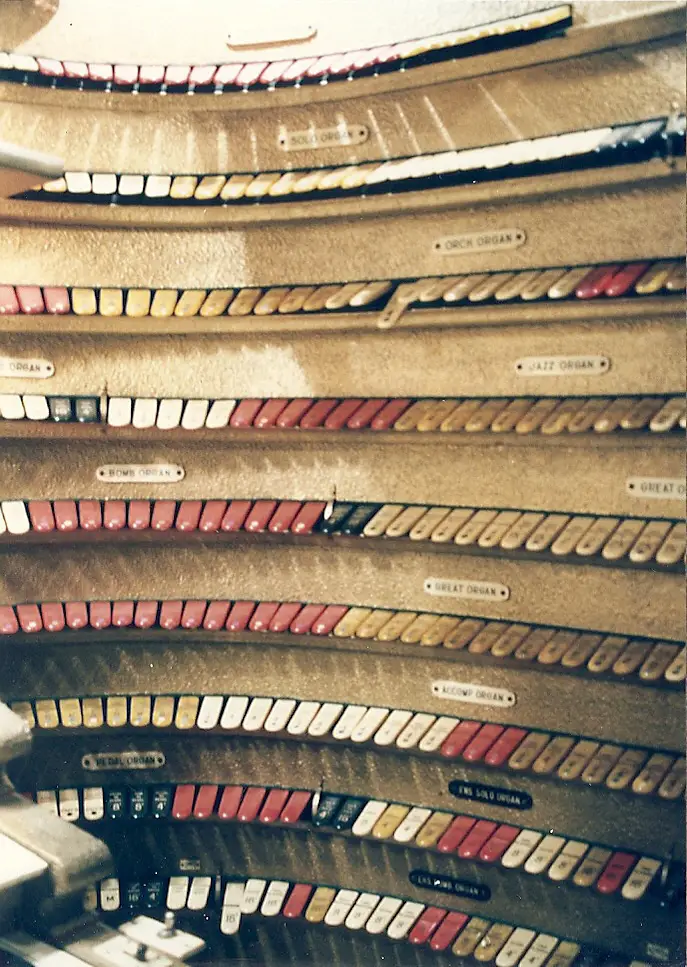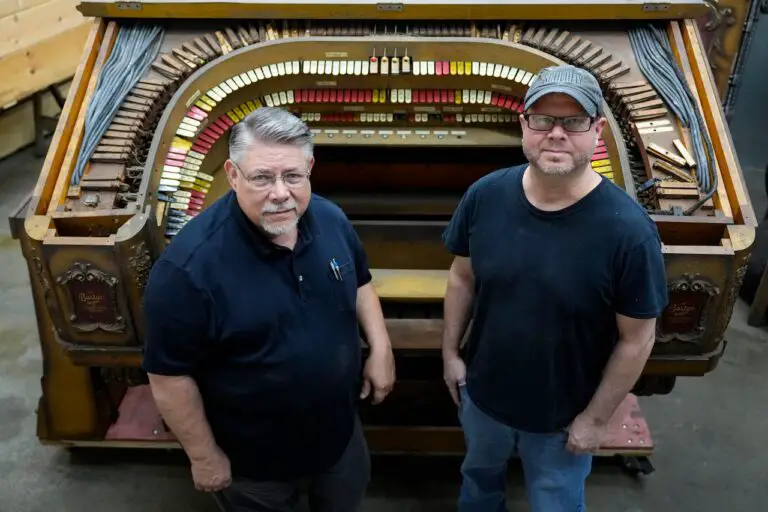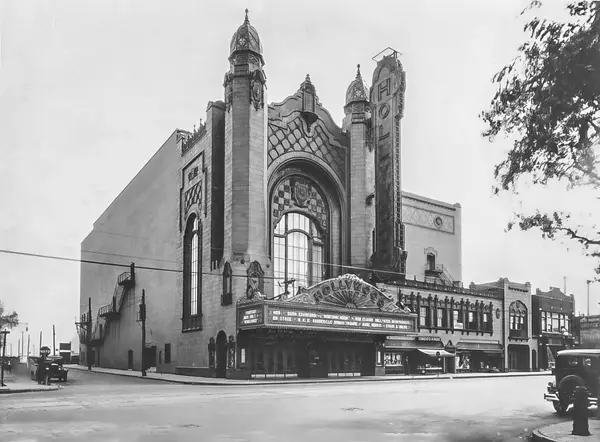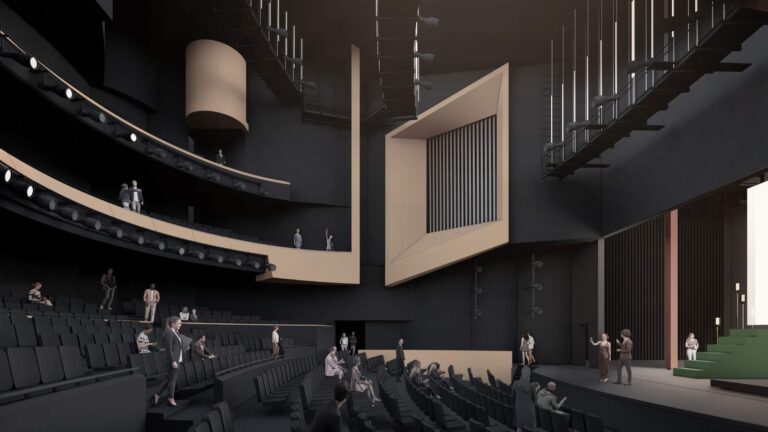

The historic Barton Opus 234 pipe organ will soon make a move from Detroit to Rochester. The nearly 100 year old instrument sat at the heart of Detroit’s silent movie industry for years before sitting in storage for over 40 years.
Now, following a restoration process, the Barton Opus will be the centerpiece of the Rochester Institute of Technology (RIT) new performing arts center.

Built in 1927, the Barton Opus 234 is a timeless marvel of the instrument making industry. Oshkosh, Wisconsin’s Bartola Musical Instrument Co. manufactured the instrument. While many can imagine what an organ sounds like, the Bartola Opus 234 was so much more. Designed to be a jack of all trades needed to soundtrack silent movies, the organ could replicate a whole host of sounds. In addition to organ tones, its keys could mimic strings, flutes, and horns.
Additionally the Opus contains various percussion instruments including cymbals, drums, and a piano aiding in this versatility. On top of all of this were various sound effects: bird whistles, steamboat horns, and more. With its host of instrumentation, the Barton Opus 234 could replicate any musical note or sound effect an organist would ever possibly need to soundtrack a movie.
The history of the Barton Opus 234 begins with the opening of its manufacturer Bartola in 1918. In that year, Dean Barton founded the company to manufacture photoplayers for theaters across the Midwest. These photoplayers were almost like primordial versions of theater organs. Working off the base of an upright piano, Bartola tacked on organ pipes and percussion instruments to aid theater organists in achieving more diverse sounds.

Throughout the 1920s, the Silent Movie industry boomed. Each year movies like Fred Niblo’s Ben Hur and the many comedies of Charlie Chaplin were released, raking in millions at the box office. While these movies were silent, music was a necessary part of the theater experience. Musical cues from live musicians built the atmosphere and told audiences how to react to scenes. In this way the silent movie experience was not silent at all.
As silent films grew in popularity, theater organs also grew – more literally. These organs soon began to take over the role of orchestra pits at theaters. They grew larger, sometimes being multiple stories high, and more elaborate with keys to replicate a host of instruments. What made Barton Organs so notably was their intricacy – not only musically, but visually. Organs like the Barton Opus featured exquisite decorated with multi-colored keys and complex wooden inlays.
During its heyday, Bartola made over 250 of these organs for theaters across the Midwest. Movie-goers everywhere from Saginaw, MI to Cedar Rapids, IA could hear their organs during film screenings. Possibly the most famous of their creations was the gargantuan organ that stood in Chicago Stadium – former home of the Blackhawks and Bulls.

The Bartola heyday could not last forever, with the company closing in 1931. As film made the transition into sound productions, the role of silent film organists slowly became obsolete. By the early 1950s, with the advent of television, which brought entertainment to the home, the medium was all but dead.
The individual story of the Barton Opus 234 very much mirrors these larger trends. After its construction, the organ found its home in Michigan, which had become a hub for silent film. Between 1925 and 1928 alone over half a dozen theaters had opened, housing over 23,000 seats. One such theater was the Hollywood Theatre, built in 1927, which went on to house the Barton Opus.
At its completion, the Hollywood Theatre was a sight like no other. Detroiters could see its massive 150 ft tall towers for miles across the city. The exterior of the building was finished with terracotta walls and red brick roofing, giving it the appearance of a Mediterranean castle. Its interior was likewise ornate. The first thing visitors would see was its 60 ft tall lobby, decorated with marble and gold, and featuring a large chandelier at the center of its ceiling.

At the center of the theater’s operations was the Barton Opus 234. At the time of its purchase, the organ was worth a whopping $75,000 – over $1 million today. Throughout its tenure, organist Bob Clarke operated the monstrous instrument, soundtracking the theater’s films and vaudeville performances. Clarke to many was better known as the organist at Olympia Stadium, home of the Detroit Red Wings.
Despite its grandeur, the Hollywood was always playing second-fiddle to other venues around Detroit. At its completion, the theater boasted a massive 3,436 person capacity – still dwarfed by the larger Michigan Theatre. Many even considered the Barton Opus only the second best sounding organ in the city. The Capitol Theatre – later renamed the Detroit Opera House – held that title.
By the 1950s, the Hollywood Theatre was in the throes of death. Its location – far from the residential hub of the city – spelled its doom. As local organist Roger Mumbrue remembered “No one lived down there. It was mostly abandoned freight yards and derelict buildings, so there was just no hope.” Not even special events, like boxing matches or new films could attract a crowd. In 1958 the theater closed for good, becoming a parking lot for Detroit’s school buses.
With the closure of The Hollywood, its assets were auctioned off to the public. Among these was the massive Barton Opus 234. In 1962, a local engineer and music enthusiast named Henry Przybylski placed a winning bid on the instrument for almost $3,500. Following this purchase, the two-story organ had to be disassembled and transported to Przybylski’s home in Dearborn Heights. For the next 40 years, the organ sat disassembled in his garage.
Fortunes changed in 2003, when Steven Ball – head of University of Michigan’s Organ Department – purchased the Barton Opus. Ball’s main goal was the safe storage and restoration of the instrument until it could find a suitable home – ideally a concert hall like it had originally stood. This came to fruition in 2019, when Ball agreed to donate the organ to RIT. It is currently undergoing restoration, with head restorer Carlton Smith estimating the process is about ⅔ complete. Upon completion, it will travel in pieces to Rochester, before reassembly in its new home at the university’s new performing arts center.

Workers broke ground on RIT’s Music Performance Theater in September, 2023. This project marks the largest theater construction in Rochester’s recent history. Upon completion, the 40,000 square foot theater will boast three stories and 750 seats. At the center of the theater is a large rehearsal hall, with two large balconies overlooking the stage. The centerpiece of this hall will be the restored Barton Opus 234 in its original glory. Upon its completion, the theater will house RIT’s musical theater productions. Current estimates say the theater will to open in January 2026.
The post Historic Barton Opus Pipe Organ Moves to RIT Performing Arts Center appeared first on NYS Music.


![Watch Pearl Jam Recruit A Fan For A “Won’t Tell” Duet At First Of Two Wrigley Field Shows [Photos/Videos]](https://utterbuzz.com/wp-content/uploads/2024/08/watch-pearl-jam-recruit-a-fan-for-a-wont-tell-duet-at-first-of-two-wrigley-field-shows-photos-videos-238x178.jpg)
![King Gizzard & The Lizard Wizard Debut All-Synth “Swan Song” In Asheville [Photos/Videos]](https://utterbuzz.com/wp-content/uploads/2024/08/king-gizzard-the-lizard-wizard-debut-all-synth-swan-song-in-asheville-photos-videos-238x178.jpg)




